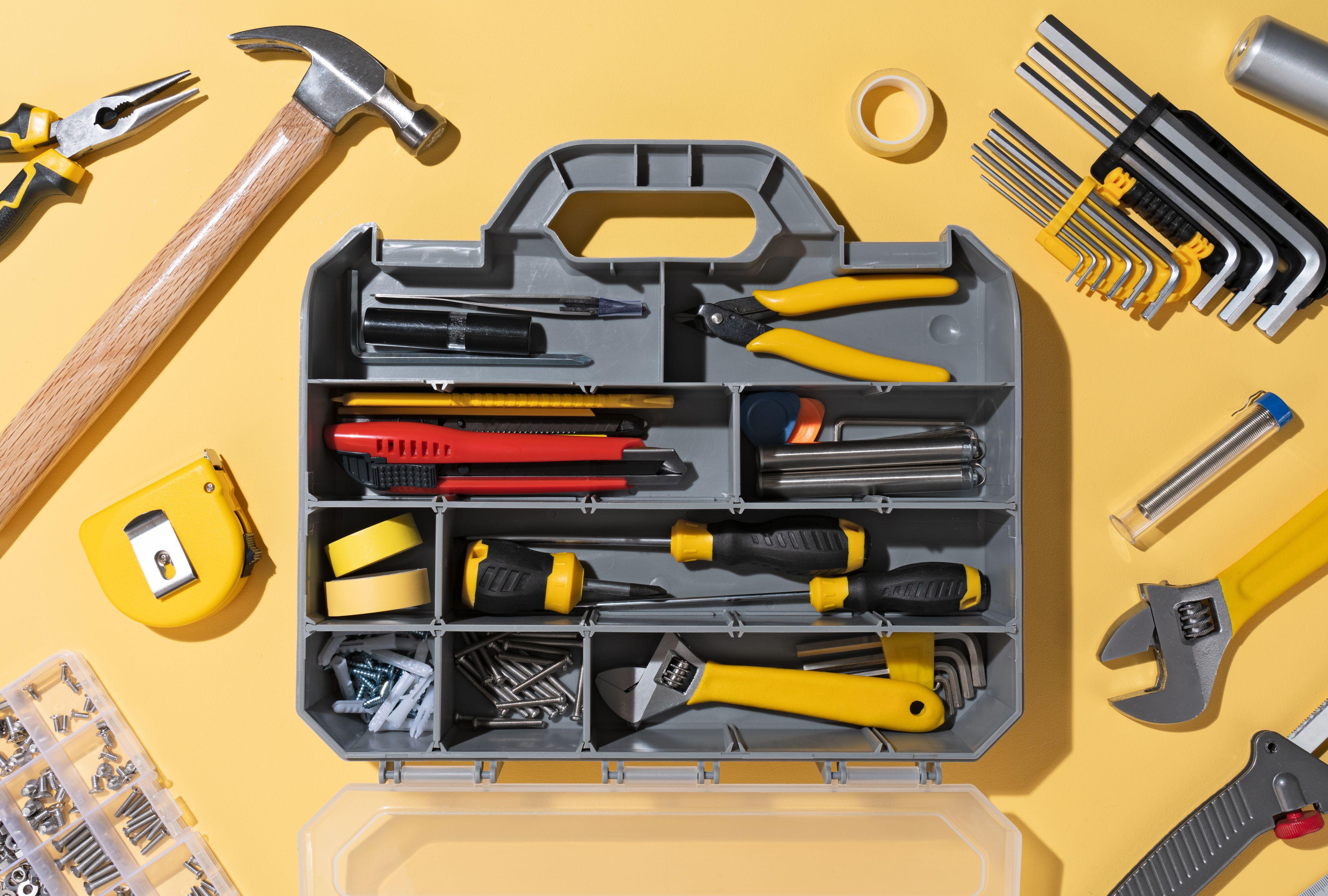Becoming a homeowner is exciting, but it also comes with its fair share of surprises. From assembling furniture to unclogging a stubborn drain, everyday issues are bound to pop up. That’s why having a basic toolkit on hand is essential.
We asked DIY experts to share the first tools they bought—and still rely on today—so you can tackle common household problems confidently, without calling in a pro for every small fix. Add these tools to your toolbox, and you'll be ready for most basic home repairs.
- Lauren Comer is a DIYer at Pinch Plate Party.
- Tom Scalisi is a contractor-turned-home improvement writer with over 20 years of construction experience.
Agnesbic
1. Cordless Drill and Bit Set
A cordless drill can make almost any home DIY project easier (and go faster). This portable, battery-powered tool is used for drilling holes and driving screws, offering flexibility and freedom without being tethered to an electrical outlet. “This was the first power tool I ever owned and it comes in handy constantly,” says Lauren Comer, DIYer at Pinch Plate Party.
Great for: Assembling furniture, hanging curtains, mounting shelves.
2. 16-Foot Tape Measure
When you need an accurate measurements on both straight and curved surfaces a 16-foot tape measure is a must. A tape measure typically includes a housing to store the retractable ribbon, a hook on the end to secure to an object, and a lock to hold the tape at a set length. You’d be surprised how often you’ll need one. In fact, you might as well get two!
Great for: Making sure furniture fits, sizing window treatments, garden planning.
3. Multi-Bit Screwdriver
This single-handled tool comes with several Phillips and flathead bits, all but guaranteeing you’ll have what you need, says Tom Scalisi, a contractor-turned-home improvement writer with over 20 years of construction experience. This is a convenient and space-saving alternative to carrying many individual screwdrivers. Bonus: You can often store the bits in the handle, so they're always handy when you need them.
Great for: Tightening or removing screws on cabinets, outlet plates, furniture, knobs, and pulls.
4. Hammer
Whether you're using it to pound a nail in the wall or to tap a pry bar, a hammer is essential to home ownership. The claw is just as useful for removing nails. Something around 14 to 16 ounces is perfect for light household tasks.
Great for: Hanging pictures, pulling nails, assembling furniture.
5. Stud Finder
A stud finder lets you locate wooden or metal studs behind a wall by using magnetic fields or density sensors to detect changes in the wall's structure. Magnetic stud finders detect metal fasteners, while electronic stud finders sense differences in wall density, allowing you to find studs for securely hanging items like pictures, shelves, or grab bars. Comer finds the battery-powered version most accurate on a variety of wall types.
Great for: Locating wall studs for mounting artwork, shelves, and other heavy objects.
6. Torpedo Level
A torpedo level is a short level with multiple vials that detect horizontal, vertical, and 45-degree angles, making it ideal for tight spaces and short-distance measurements. Walls and floors are rarely perfectly level, so this ups your DIY game above just “eyeballing it.”
Great for: Leveling artwork, shelves, furniture.
Related
7. Drain Snake / Auger
“Plumbing work is expensive and drain snakes aren’t,” Comer says. That's why it makes so much sense to add a drain snake, also known as an auger, to your tool kit. With its flexible metal cable and a cutting head on the end, a drain snake is designed go into a clogged drain and break through whatever blockage is causing the problem. It's a handy and effective tool for homeowners and plumbers to clear sink, shower, and other drain line clogs.
Great for: A slow sink, shower, or toilet, and tub maintenance and clogs.
8. Tongue-and-Groove (aka Channellock or Pump) Pliers
Channellock pliers, also known as pump pliers or tongue-and-groove pliers, are adjustable-jaw pliers with long handles to provide gripping power for plumbing, electrical, and mechanical tasks. They’re adjustable so they fit a wide range of pipe sizes or fasteners, and most have serrated jaws that allow them to bite down on any material. “By far the most useful type of pliers,” Scalisi says.
Great for: Plumbing problems, fixture replacements, tightening a wall-mount handrail.
9. Flat Pry Bar
This heavy-duty pry bar features a curved, rocker-like "gooseneck" for better prying power, beveled ends for accessing tight spaces, and one or more slots for pulling nails. “A lot of new DIYers jump into projects like trim and moldings, and without a good flat pry bar, they’re often doing more damage than they realize,” Scalisi says. A flat pry bar is ideal for this task.
Great for: Removing trim without damaging drywall, door/window installation, carpet removal.



